-
Car Reviews
- All reviews
- Midsize SUVs
- Small cars
- Utes
- Small SUVs
- Large SUVs
- Large cars
- Sports SUVs
- Sports cars
- Vans
Latest reviews
- Car News
-
Car Comparisons
Latest comparisons
- Chasing Deals
How does Hyundai’s current cheapest EV stack up as a daily drive across six months in the Chasing Cars garage?
In two generations, the Hyundai Kona has fast entrenched itself as one of the Korean brand’s most important nameplates.
We reviewed the Kona Electric at its early-2024 launch and walked away quite impressed with the overall package, but what’s it like to live with this small battery SUV as a daily drive over a long-term period?
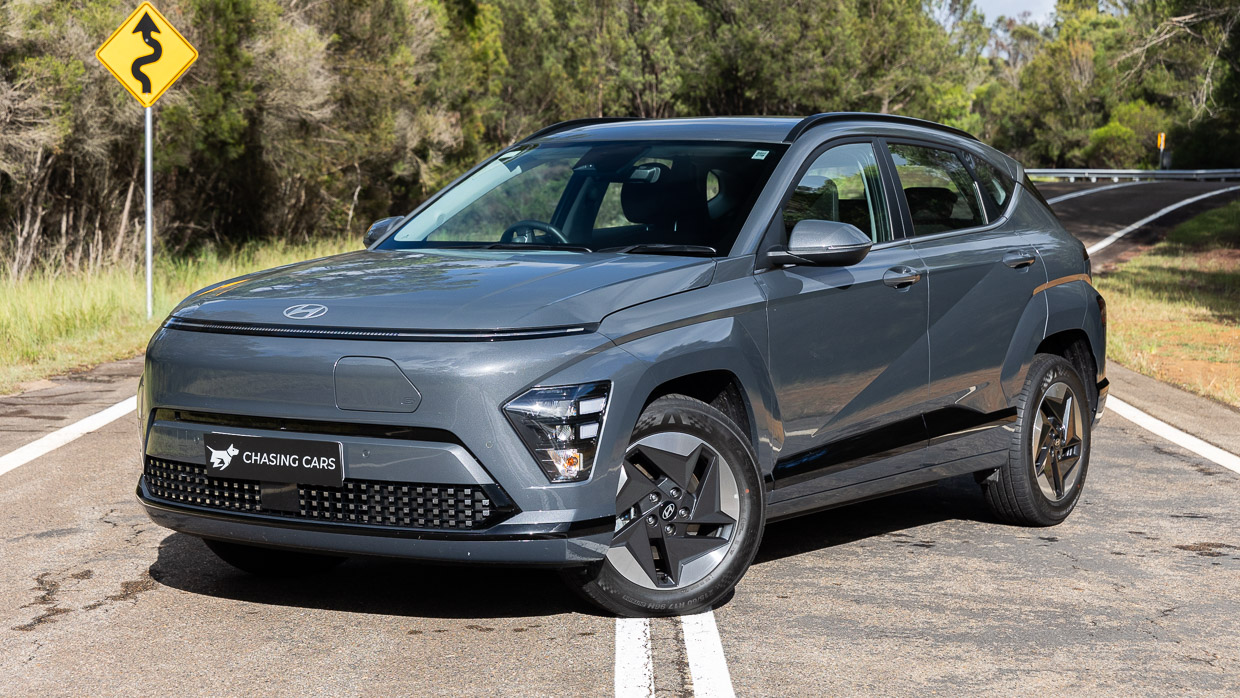
Does the ownership experience stack up, and should Aussies be considering this over the petrol and hybrid variants? And, crucially, is the value proposition there in the face of ever-increasing Chinese competition?
With the Kona Electric becoming the newest long-term member of our Chasing Cars garage, we intend to find out.
It was hard to believe that six months had passed so quickly with Agnes, but it was time to begin the farewell tour!
Across six months in the Chasing Cars garage Agnes had travelled 5827km and I’d spent around $450 on charging expenses, equating to about $75 a month – very affordable!
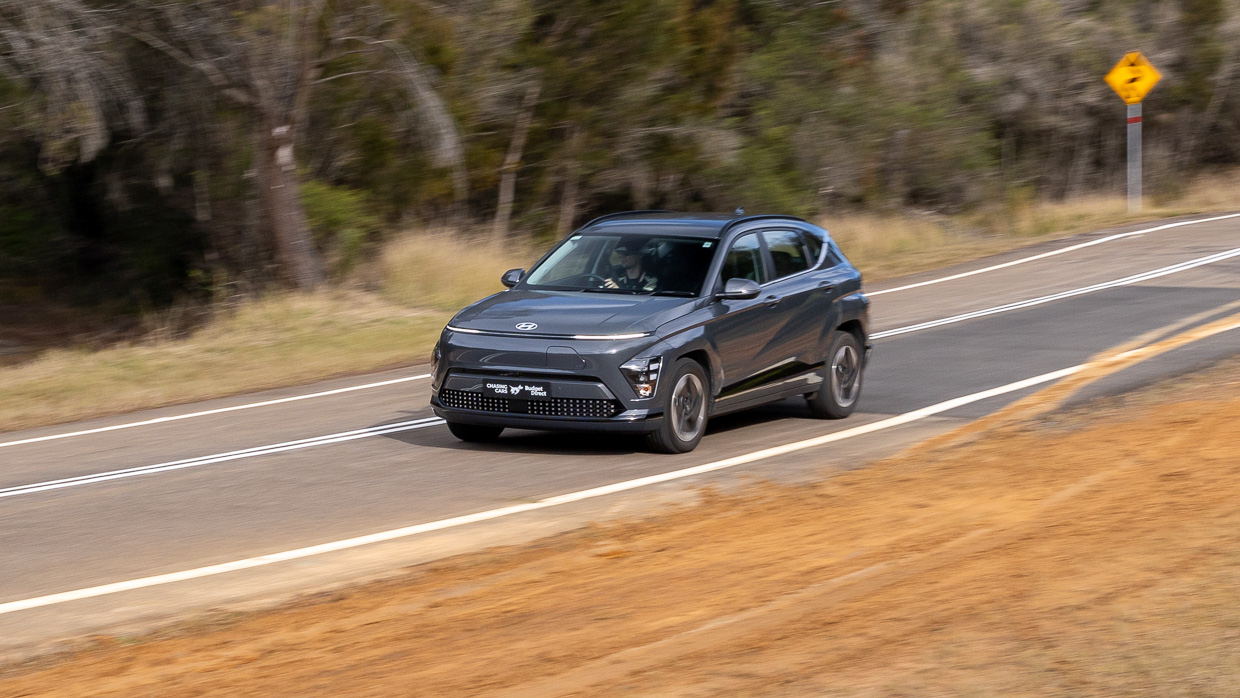
On top of this, it was an almost entirely fault-free ‘ownership’ experience.
Why almost? After some more vigorous country driving testing out the Kona’s dynamic capability I started to hear a subtle creaking noise from the rear of the vehicle. Had we driven too hard? Had something become loose?
There were no obvious signs of any damage or loose components, the spare wheel seemed secure. I kept driving. But the creaking persisted. In a quiet car like the Kona it’s enough to grate at you, and so a trip to Hyundai was booked!
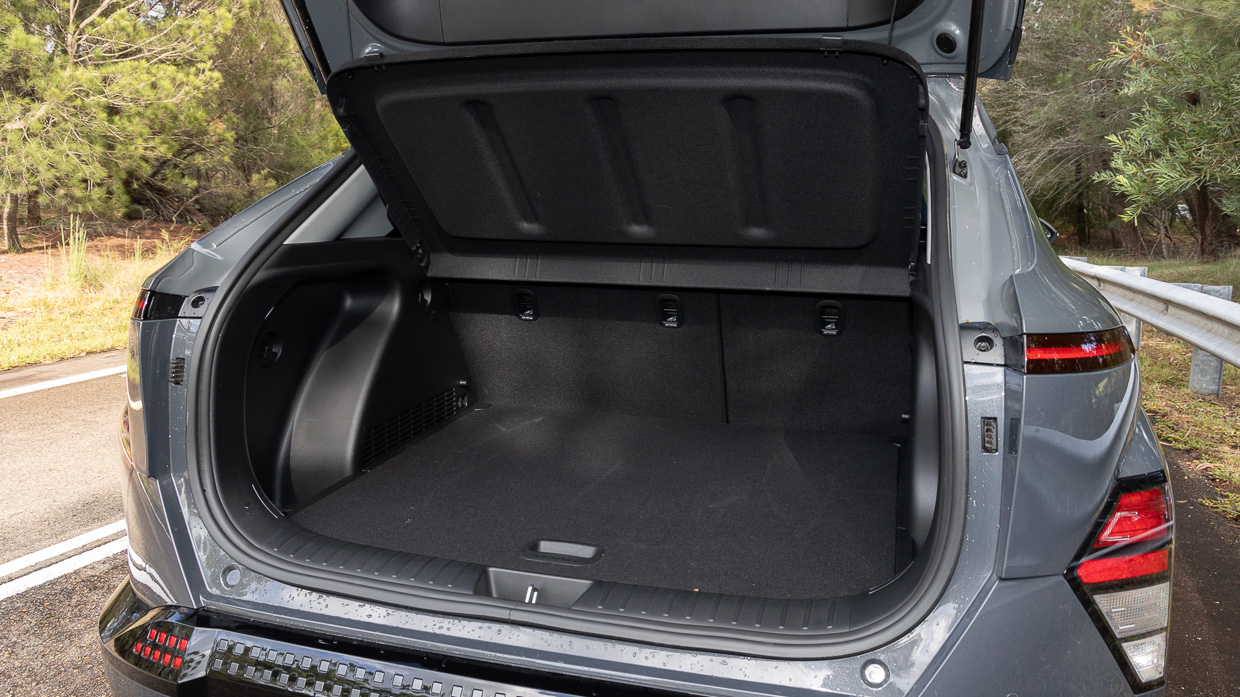
Within 30 seconds of sitting in my front passenger seat the mechanic had diagnosed it – the tailgate stoppers were the culprit. He explained that because they are hard rubbers they go dry after a period of time and the solution is a bit of lubricant, which was applied swiftly and I was on my way. Easy!
This was the only issue that I experienced across six months with Agnes. Other than that, faultless.
And this brings me to my favourite aspect about the vehicle: it’s fun to drive.
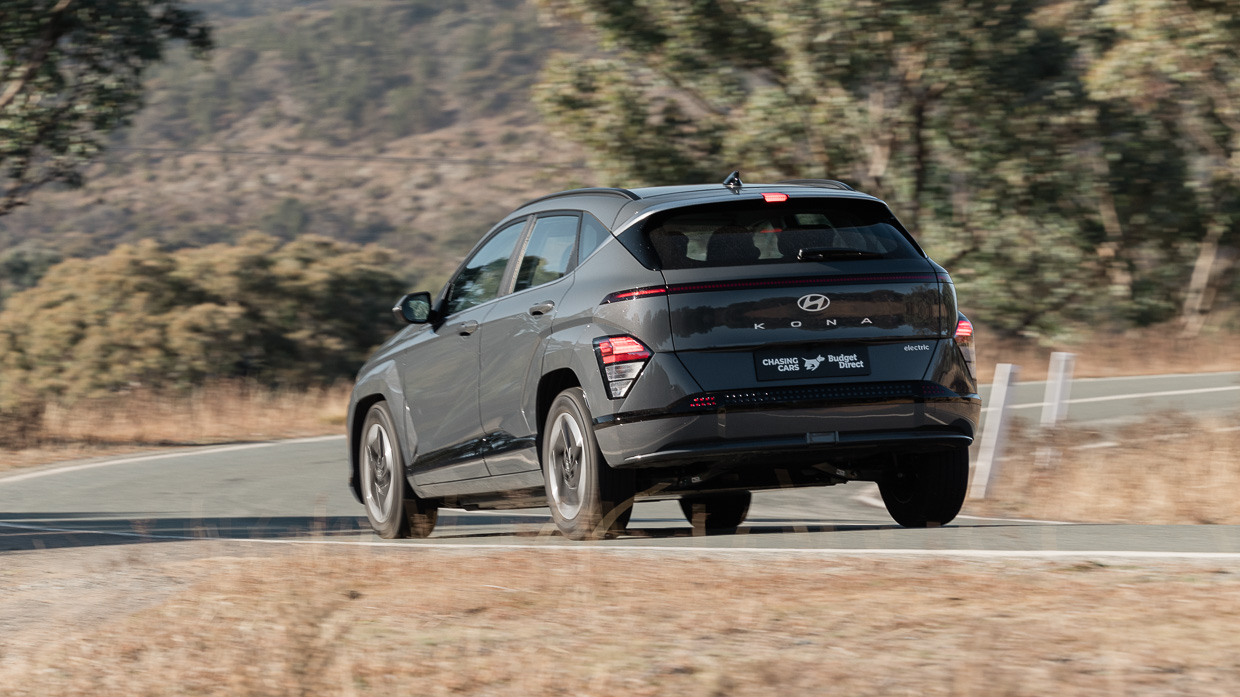
The Kona has a great dynamism and fluidity to it which makes for a pretty chuckable vehicle around any corner.
It’s no sports car but the chassis is spirited, gives you a good deal of communication and confidence and ultimately – coupled with all the other elements like the well-weighted steering, natural throttle and braking inputs – makes for what is an enjoyable, rewarding and satisfying vehicle to steer.
As my first entrance into the electric life, I was blessed to experience it with Agnes. I’d learnt a lot about EVs, and grown to appreciate what they offer as a daily commuter.
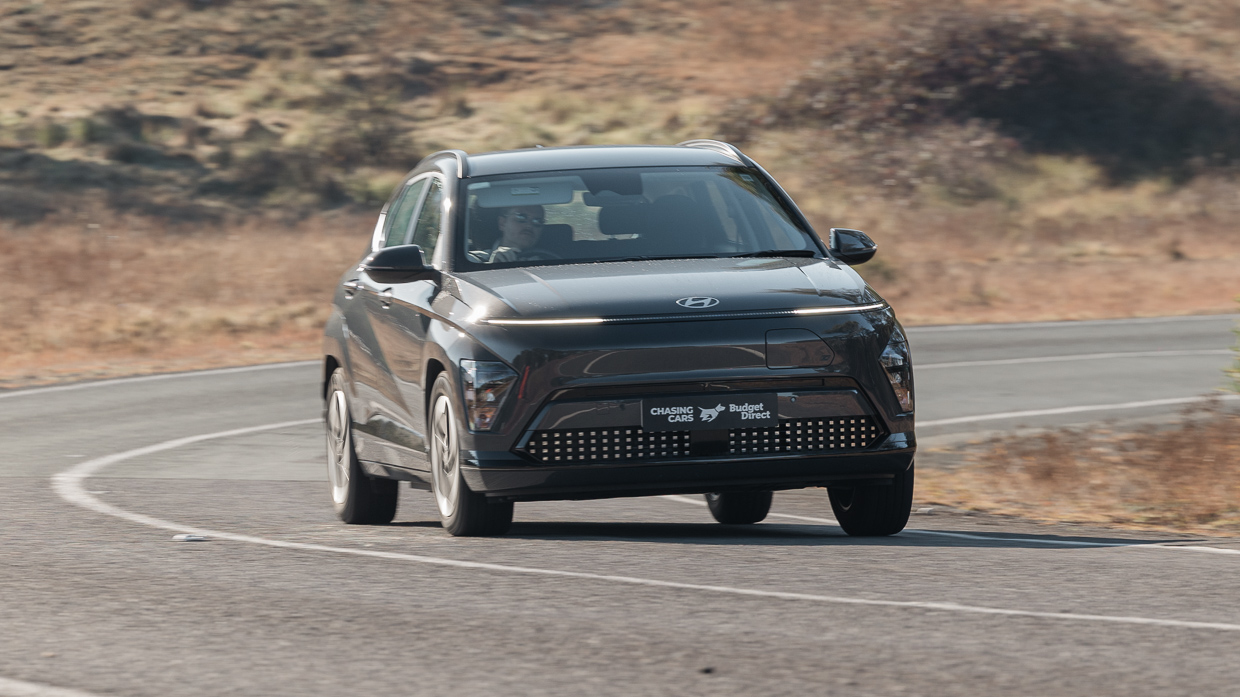
The caveat is that it is all dependent on your personal situation. The fact I couldn’t charge at home was annoying, and so for me I’d be stepping up to the Extended Range as a result.
Indulging, I’d also be leaning into the Kona’s design further with an optional N-Line package and a more exuberant colour like Soultronic Orange or Neoteric Yellow. I think that’s where the Kona’s design pops best!
But for me, the final consideration is price. At $54,000, you’re essentially spending just about $60,000 driveaway to access this small electric SUV.
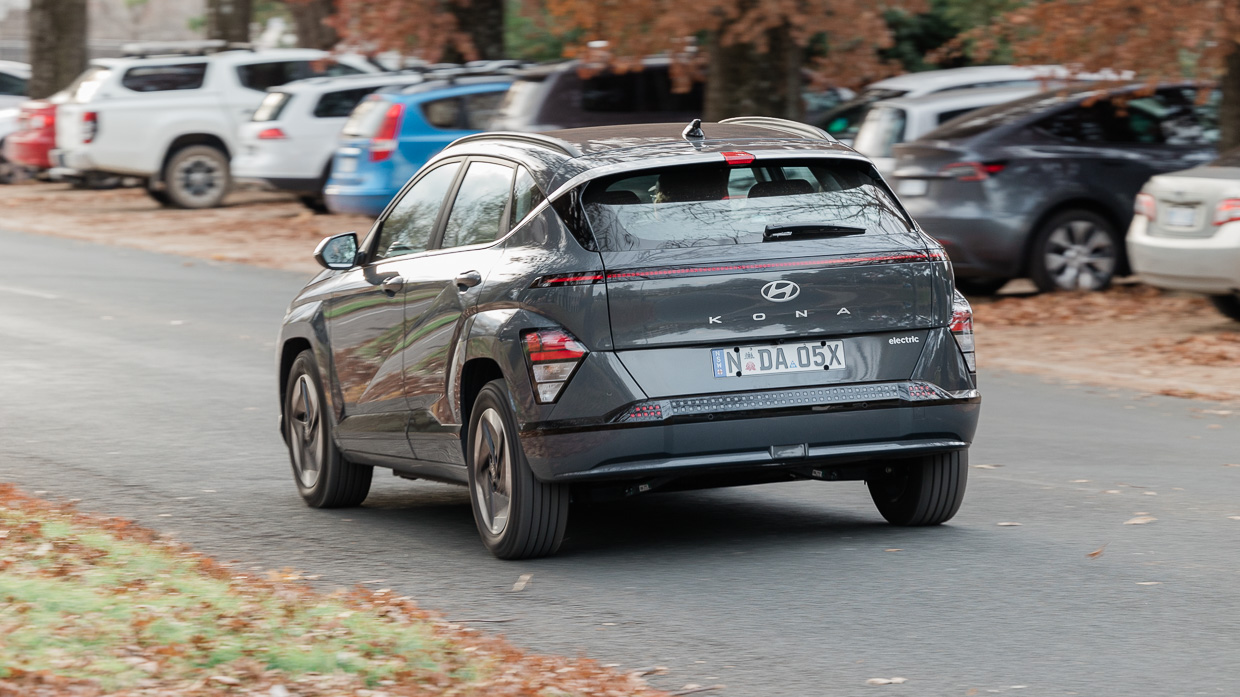
Some might argue that a competitor like an MG4 or BYD Atto 3 presents better value for money, and on paper they certainly do, however removing price from the equation, I think the Kona offers the more compelling complete package and drive experience.
This said – for almost $20 grand less than the Kona Electric Standard Range you can step into the base hybrid. Granted, you lose the benefits of electrification including the added refinement, quietness and torque, but based on my personal circumstance, this is the path I’d be going down.
If I did have the home charging infrastructure then I’d be looking to secure a novated lease on the Kona Electric to help bring the higher price down and take advantage of the fringe benefits tax exemptions that come with that.
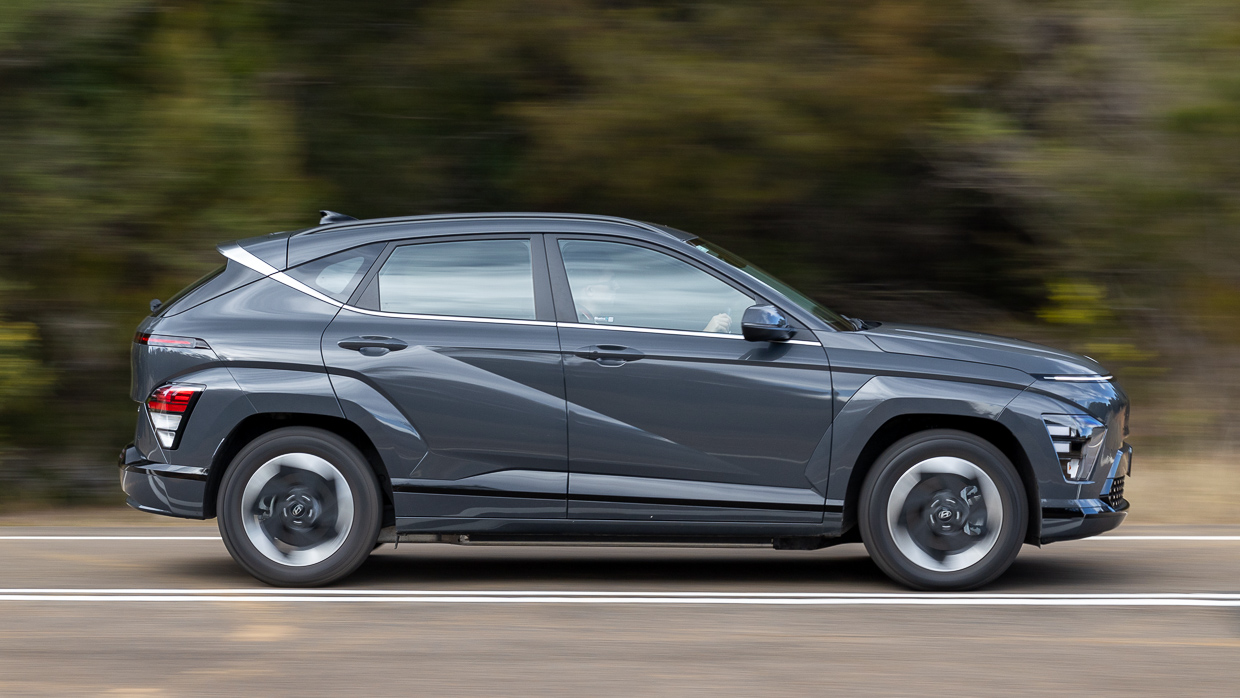
Either way, charging logistics and drawbacks aside, I’d grown attached to Agnes and I’m sad to be saying goodbye. As a model lineup, hybrid, petrol or electric, Kona is a nameplate I’d happily recommend.
Farewell Agnes, I hope we meet again!
I was now well and truly accustomed to Agnes as a daily driver and was very much enjoying the benefits of electrification – the instant torque, the smoothness and quietness around town and in traffic.
Every drive in the Kona I was reminded how smooth and pleasant it is to drive. Not all that but it’s also easy – for someone stepping in from a petrol car, there’s no learning curve required given how natural and intuitive all the throttle and steering inputs feel.
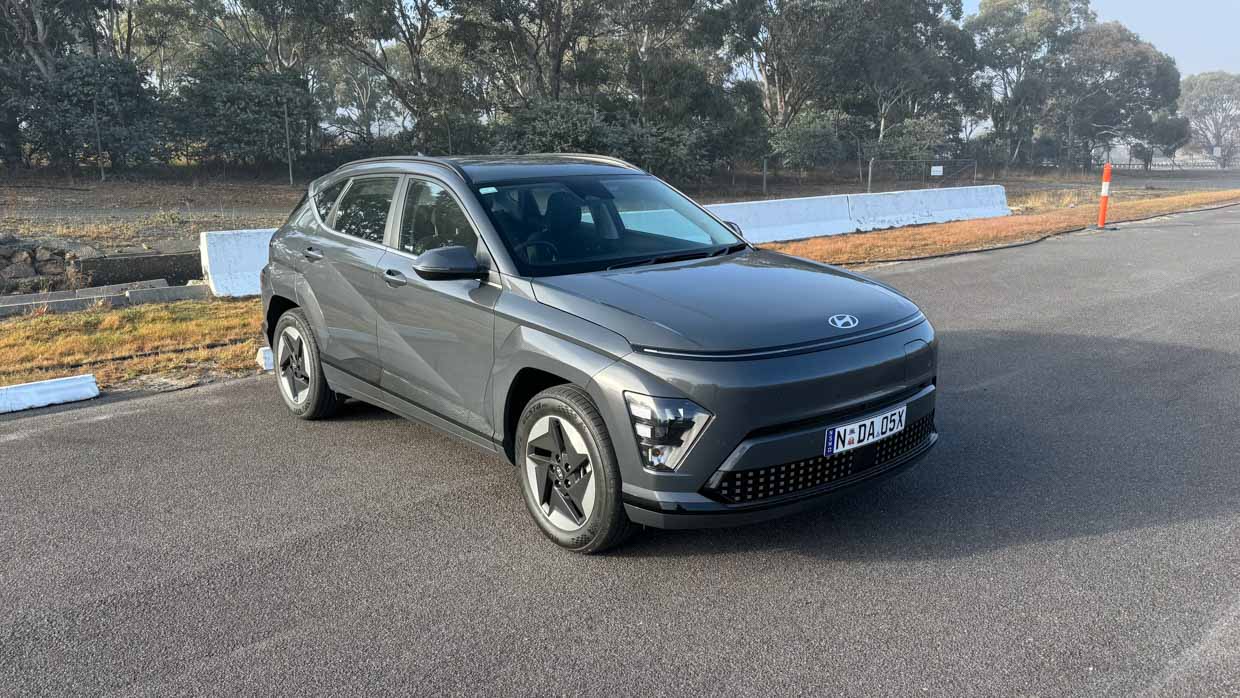
Perhaps the biggest difference for those coming from a combustion car would be the regenerative braking, however this can easily be tailored to your personal taste based on whether you like it or not using the paddles on the steering wheel.
I grew accustomed to keeping the Kona in maximum ‘i-Pedal’ mode as much as possible and enjoyed the extra level of engagement of a one-pedal driving experience.
All was looking good for Agnes, but a bigger challenge was looming.
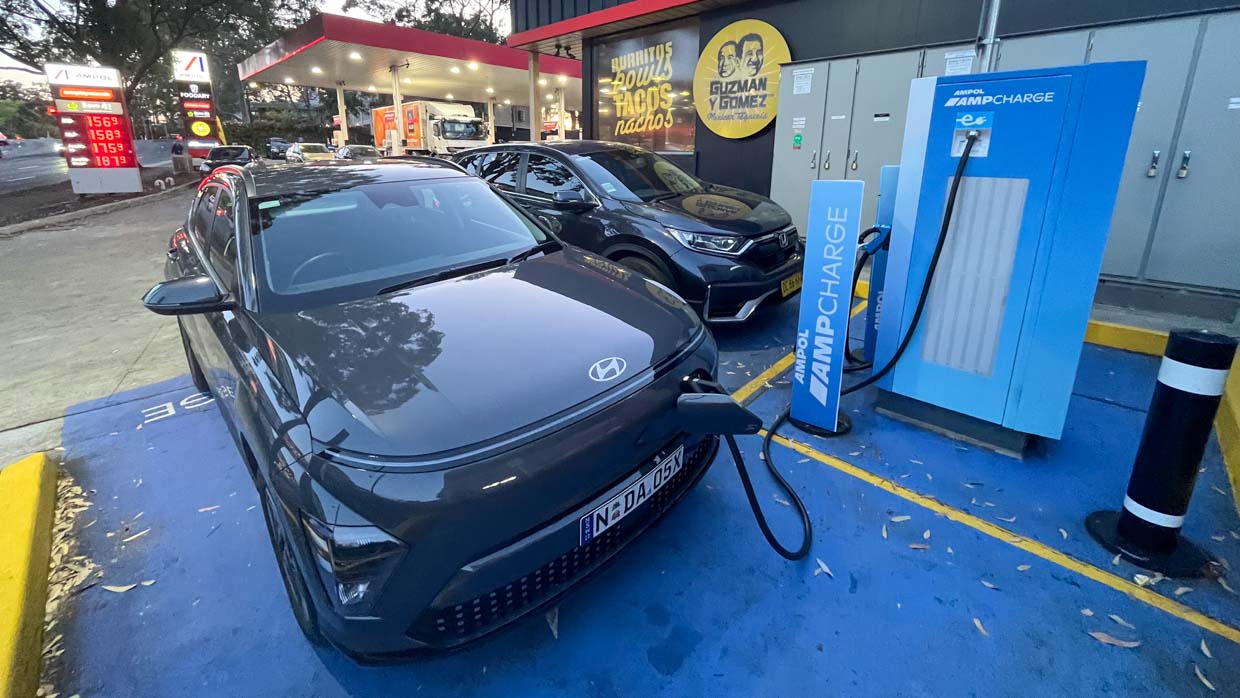
Outside of the daily drive to and from work, weekend errands and family visit, the furthest I’d travelled so far was from Sydney to Newcastle and back, around 130 kilometres each way.
Provided I had the Kona fully charged, or the ability to top up during the journey, I could just make it with a decent amount of charge to spare, but what about a longer ~300km trip from Sydney to Canberra?
Before setting out for the trip we conducted our official Chasing Cars highway range test to see what we’d realistically be playing with.
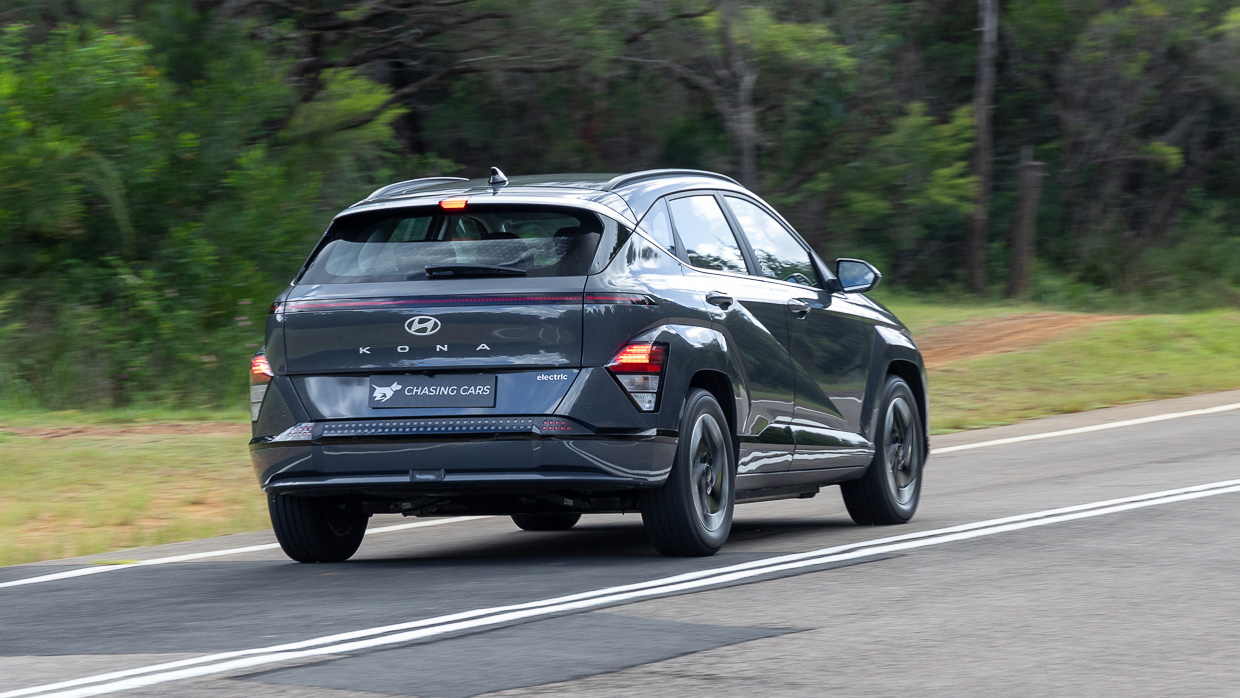
To perform our test we need to know the usable battery size of the vehicle we’re testing however Hyundai doesn’t have this data publicly available, quoting only the gross 48.6kWh size. Therefore, this required some assumptions on our end. For the purpose of the test we assumed a usable battery size that was 95 per cent of the gross, so 46kWh.
Over the course of our 180 kilometre highway test loop we delivered an efficiency of 15.5kWh/100kms and an implied highway range of 296km, noting that we’d expect shorter range at highway speeds where EVs are generally less efficient compared to urban driving where I could comfortably get between 350 and 400 kilometres of range from the Kona.
So – at 296 kilometres of implied highway range, could I make it to Canberra on a single charge?
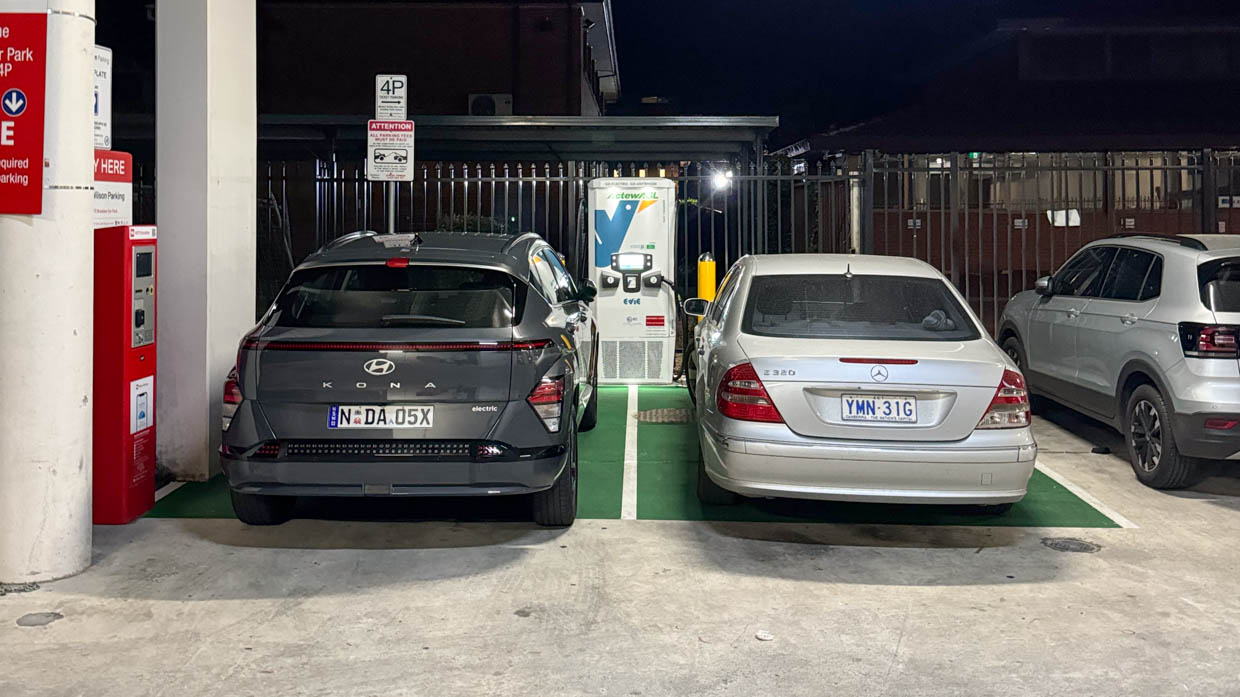
The answer: yes, but with the caveat that it was close and toward the end of the trip I was travelling below the 100km/h speed limit to conserve as much battery charge as possible.
I ended up arriving at a charging station in Braddon with 12 percent charge and a remaining range of 36km according to the trip computer, so perhaps I could have travelled at full pelt and just made it but it was something I didn’t want to risk given limited charging opportunities between Goulburn (my last pit-stop) and Canberra.
If range is a consideration for you then there’s a strong case to spend the extra $4000 for the Extended Range, which would ensure you could do the Sydney to Canberra trip without anxiety. But, we made it in any case – a win for Agnes!
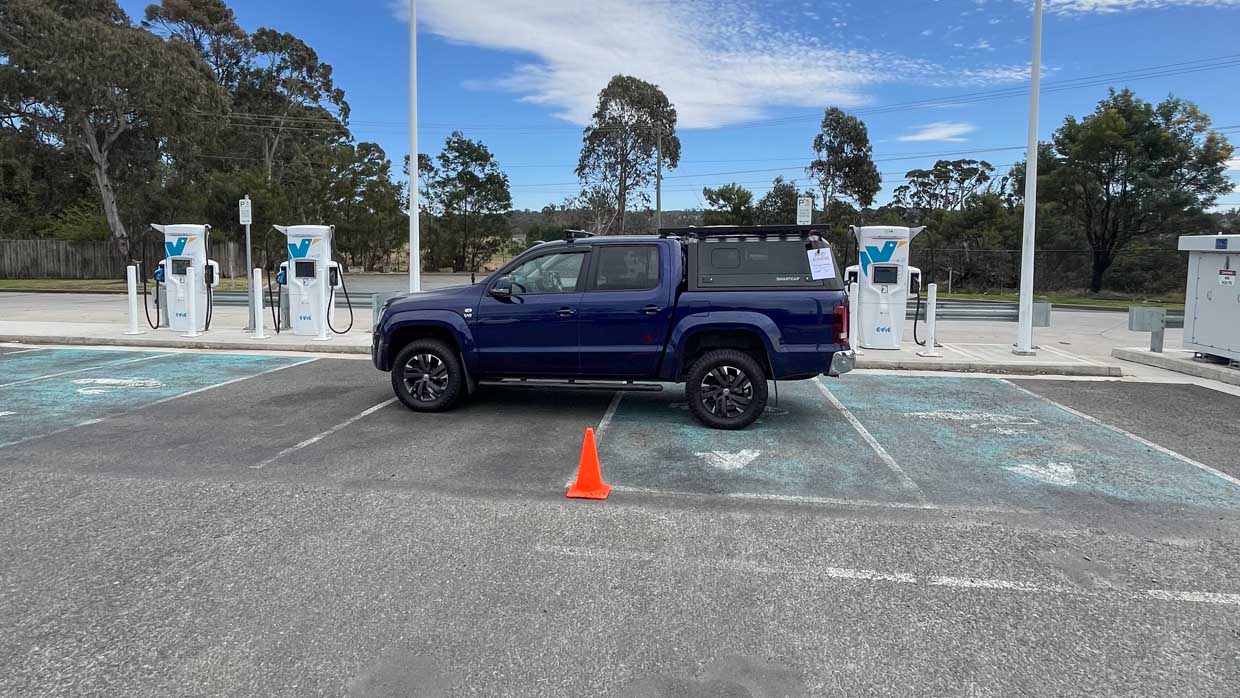
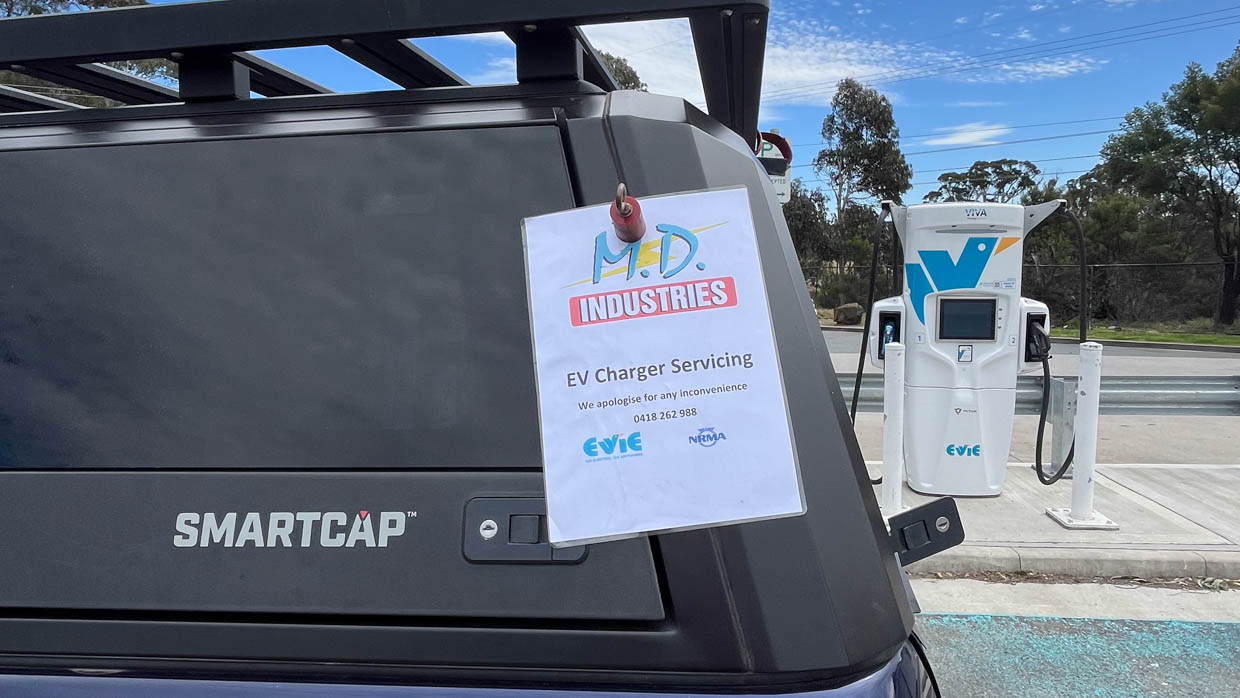
Although the irony was that after making it to Canberra and arriving at the charging station, both chargers were occupied with other vehicles – one of which was an old Mercedes-Benz E-Class!
Petrol cars taking up electric spots is something I experienced a few times during my time with Agnes, which was particularly frustrating in this situation given I had no choice but to wait so I could charge the car. Luckily a spot soon freed up, although that was thanks to a Tesla leaving and not the Merc which remained even after I left an hour and a half later… sigh!
Driving back to Sydney a few days later, the fun continued. I’d planned a charging stop at the EVIE charger at Sutton Forest (about halfway back to Sydney), however when I arrived all chargers were closed for maintenance.
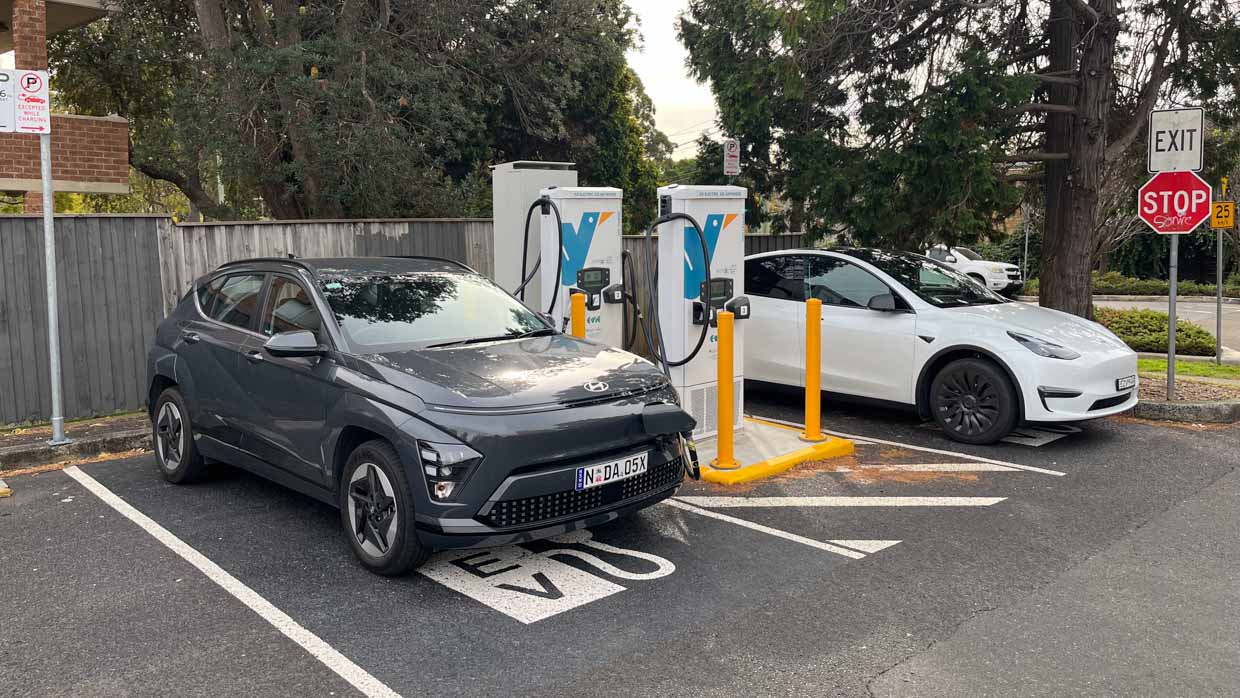
A maintenance worker told me they’d be down for ‘a while’. Luckily, I had enough charge to make it to Mittagong for my top up.
It’s these moments were an otherwise smooth electric experience could be soured, but luckily I was never in a situation where I was stranded and I quickly learnt to have a contingency in mind.
The beauty of having a long-term test car is that we don’t need to cram all of our testing – including urban, highway and country driving, interior assessment, range and charging tests – into one week. Instead, we can take our time to focus on each individual element.
And so, as month two began, it was all about immersing myself in the basics: the interior ergonomics, functionality, and what it’s actually like to live with the much maligned ‘beeping and bonging’ of the safety systems that every automotive journalist seems to bang on about?
Let’s start with the positives.
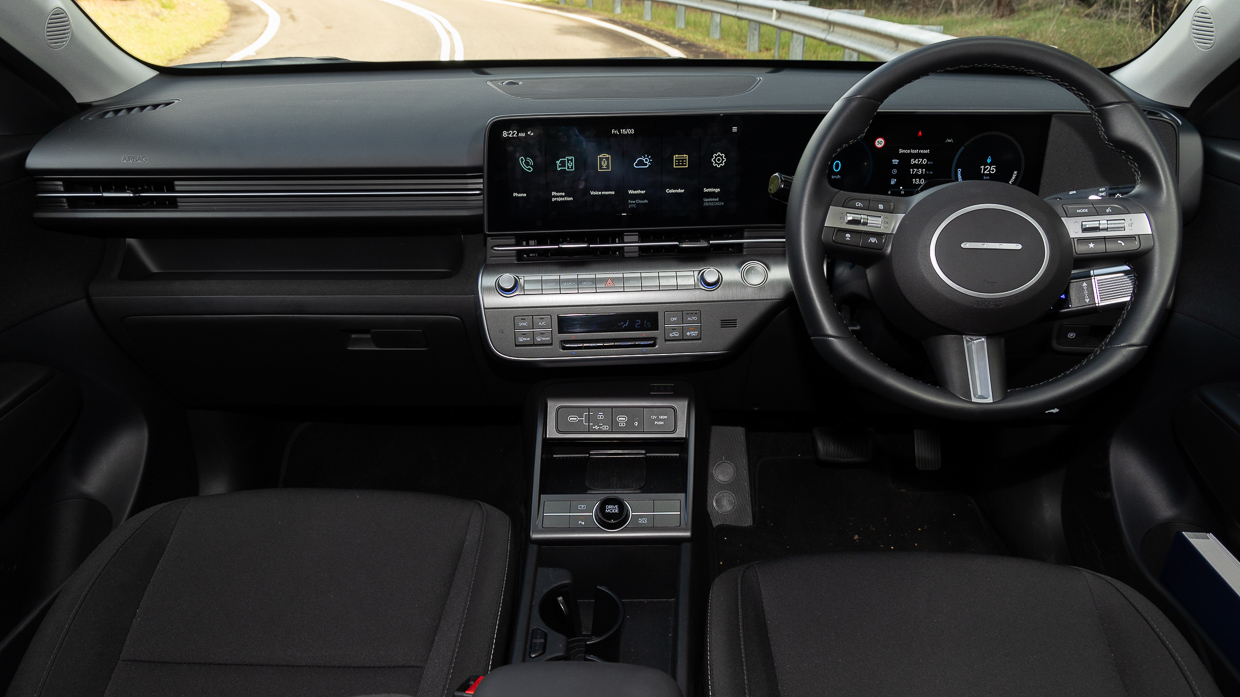
One of my favourite aspects of the Kona is its excellent blend between modern-world tech and traditional functionality.
Putting it plainly, you’ve got two quality screens in front of you, but they don’t dominate the cabin, and you still have plenty of physical knobs and buttons you can interact with for functions such as the volume, climate controls, drive modes and other short cuts.
Having all these buttons makes the cabin vibe a bit more utilitarian and honest, but you’ve still got all the benefits of two crisp and easy-to-use 12.3-inch screens for the digital instruments and infotainment.
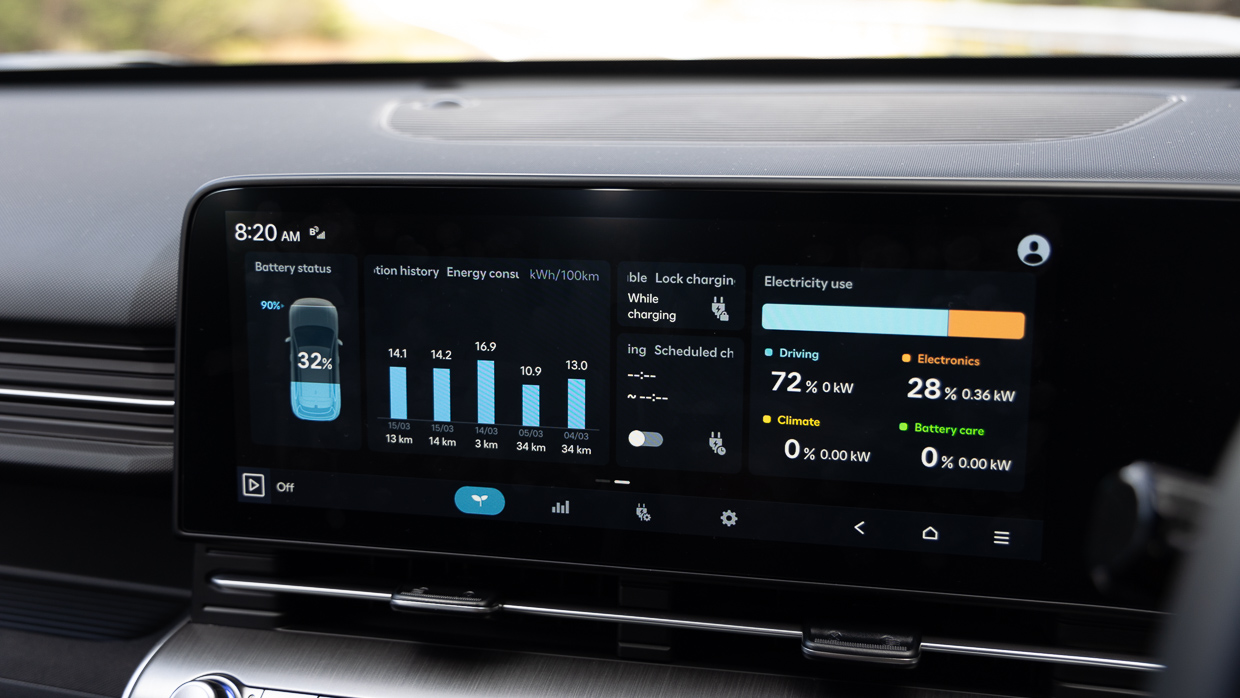
I appreciate how simple the graphics are, particularly for the digital instruments – two-dimensional, flat, simple, they do the job and don’t overwhelm you with unnecessarily over-stylised graphics.
And while I appreciated the graphics and responsiveness of the infotainment, I spent most of my time using Apple CarPlay, which always worked well.
Nit-picking, I found that I had to lean forward slightly to interact with the screen. That’s a criticism I have of many cars and could be a symptom of my long legs and short torso. But it’s also one of the reasons why I always appreciated cars with rotary knob controllers on centre consoles.
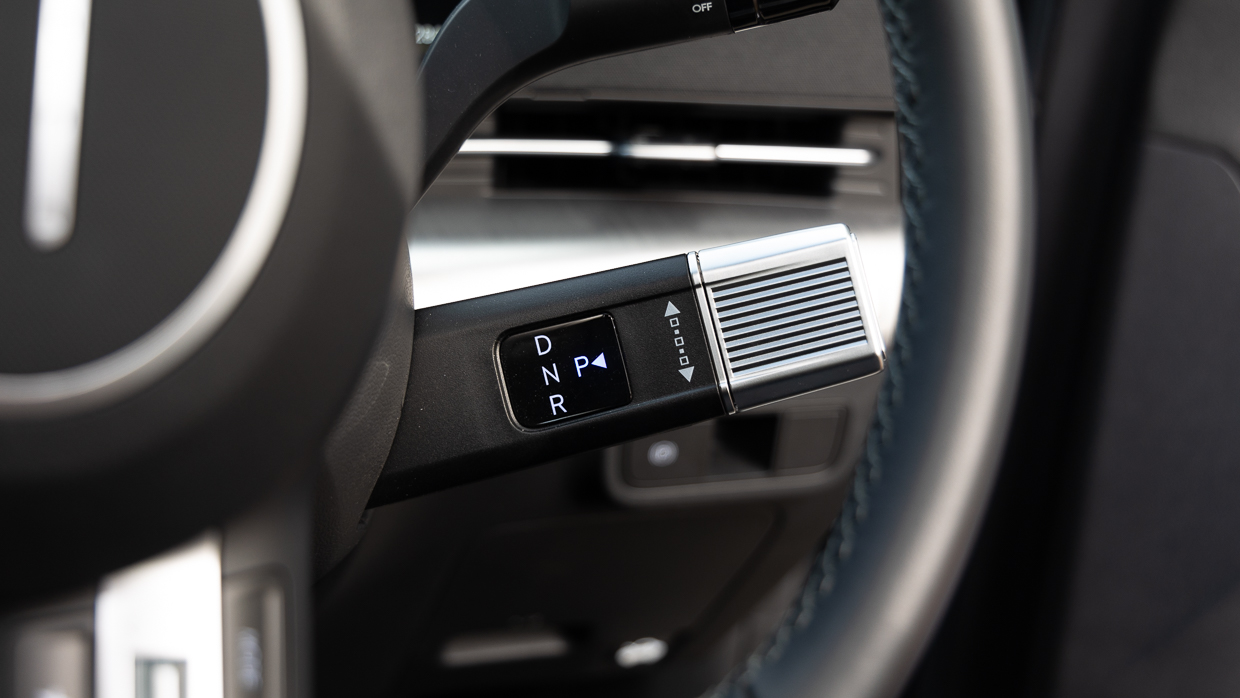
Speaking of ergonomics, the column-mounted transmission selector did take a bit of getting used to. Most of the time it’s not an issue, but there were those few moments when I was in a rush and when I had to stop and think about whether I was in drive or reverse, and which direction I should rotate it. The twist functionality that always reverts to the centre isn’t all that intuitive.
It’s for this reason that I like the more traditional approach for column mounted shifters that brands such as Mercedes-Benz employs where you have a tangible shift into drive or reverse and the lever remains in that position until shifted again.
This mightn’t be a bother for everyone, and there are big upsides including the amount of room you gain in what is already a very spacious cabin. There’s lots of open space in the centre console which is a good thing, but on the downside it’s all open and there’s only a small, enclosed section.
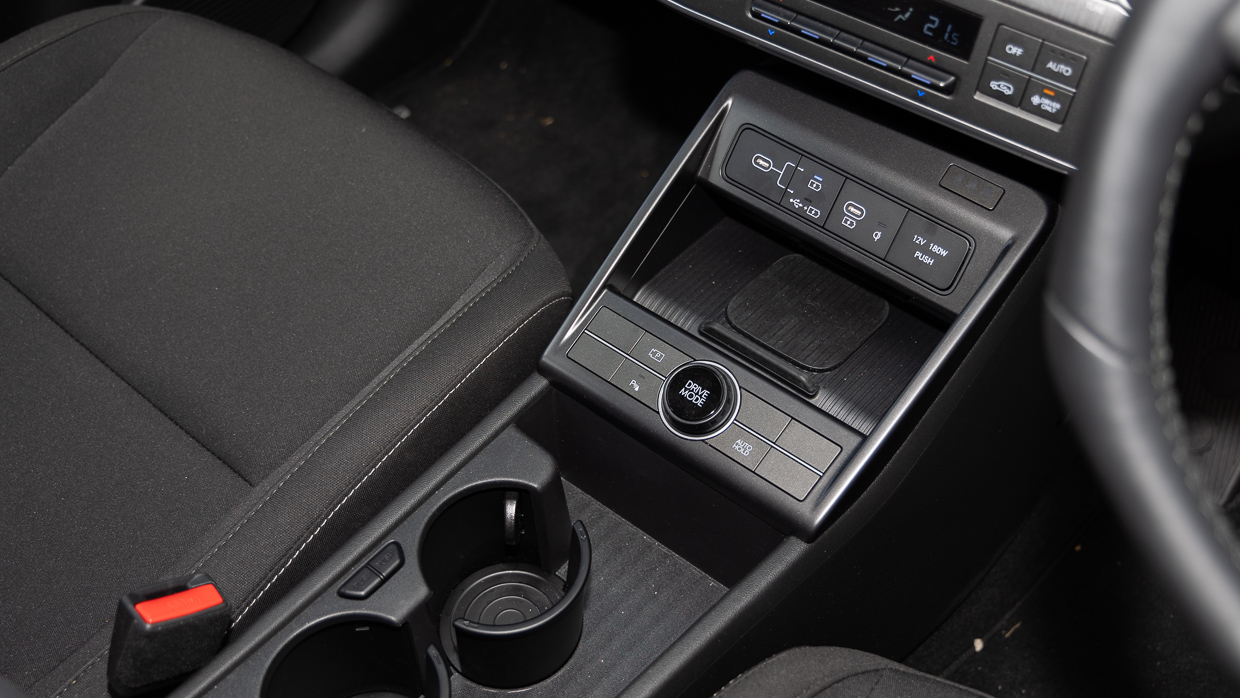
There are also quite a lot of hard scratchy plastics too, and combined with the dark cloth trim, that all reminds you that you’re in a base model Standard Range, but on the plus side, it all feels solid and well built.
So, how did I cope with those safety features you might have read so much about?
Well, look, they are pretty annoying but I got used to them and my experience got better following an over-the-air update.
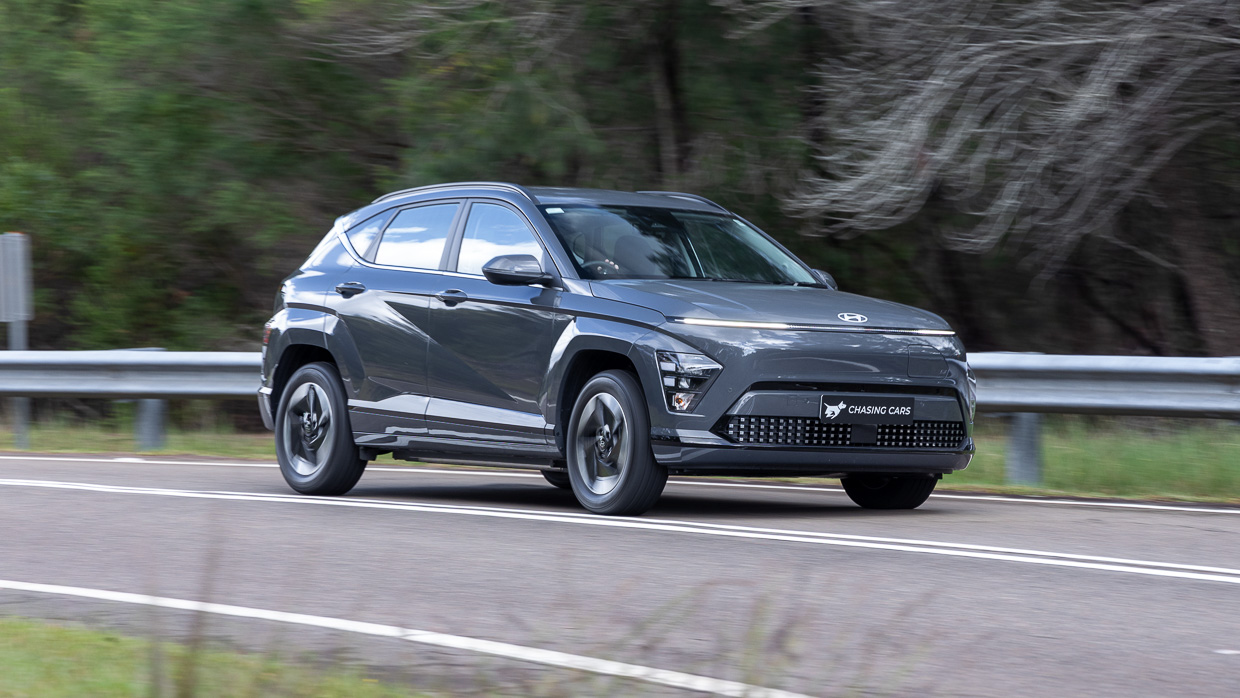
To recap, the main safety feature in question is the speed limit warning that not only flashes a graphic in front of you if you’re over the speed limit, which I don’t have any issue with, but it also sounds audible beeps if you go over, which is what’s generated the most flak.
The issue most journalists have noted, which is not just Kona-related, is that often the vehicle will get the speed limit wrong (as in, it can’t tell if you’re driving outside of school zone timings) and beep at you for going over the speed limit, even if you aren’t.
To compound this annoyance, if you want it switched off, then you need to do that every time you get in the car.
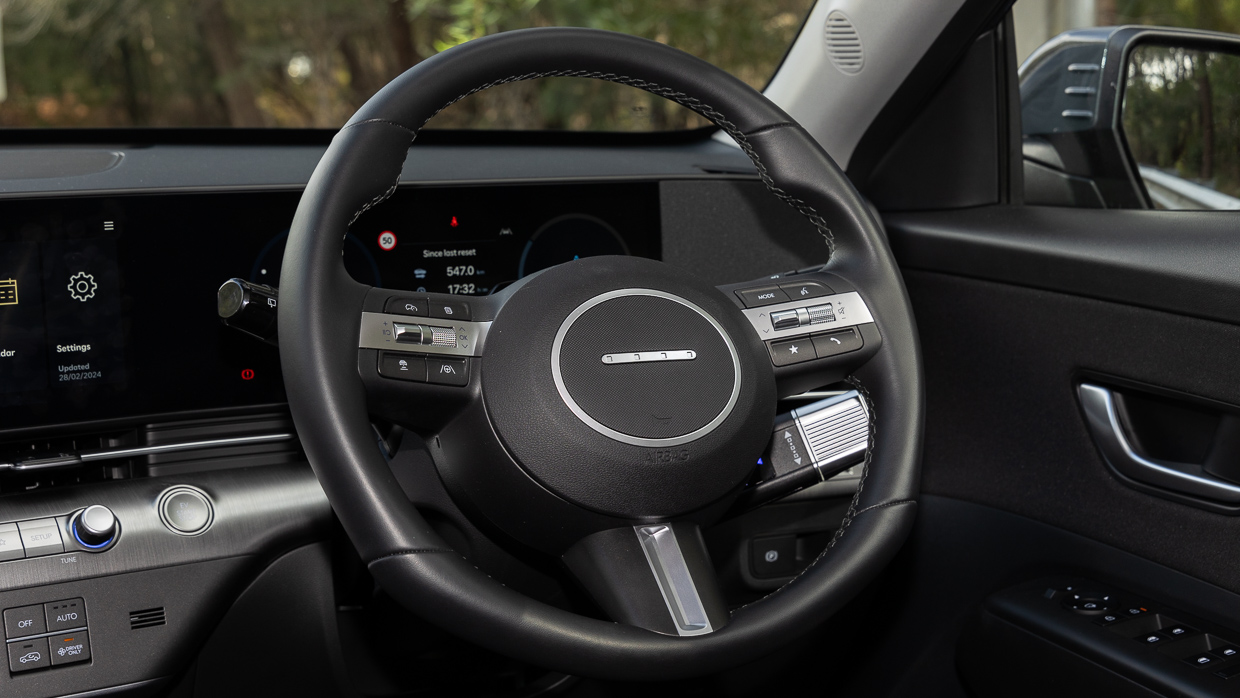
For my first several weeks with the Kona this required a minimum of three button presses once a shortcut was set up on the steering wheel. Again, every time you get in the car, which gets old pretty quickly.
However, some time into my run with the Kona I arrived at a breakthrough.
The Kona ran an over-the-air update one night which resulted in an update that brought the number of button presses down to one. Now all I had to do was press the mute button on the steering wheel once, for five-seconds, to switch the audible warning off.
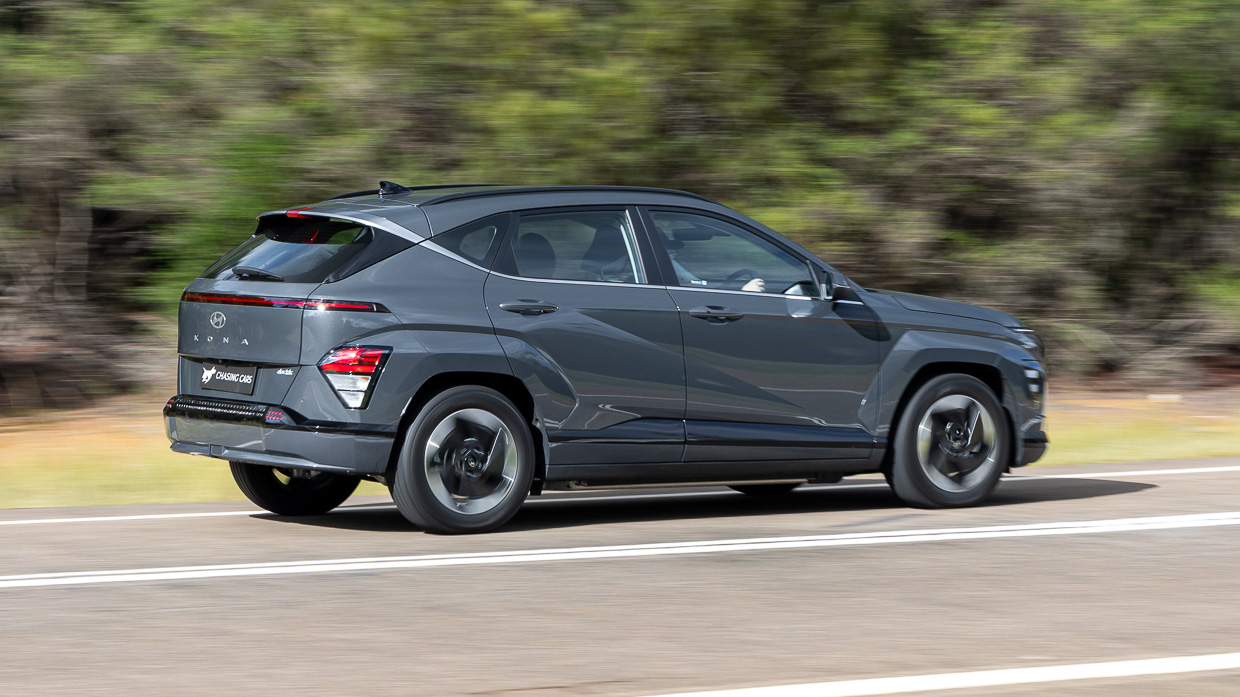
Yes, it’s still every time you start the car, but it made a difference – except when I was on the phone with someone and realised that I would also mute my phone conversation at the same time.
As well as this, there’s also the driver attention warning that beeps at you when it deems that you’re distracted or that you need a break to manage fatigue. This often sounded for me too, however it was less frequent, and they were good reminders that perhaps I was interacting with the media interface or did indeed need a break.
So, the beeping and the bonging: there’s a bit of it, yes, but it got better throughout my time with the car. It’s something that I’d recommend trying out during a test drive to see if you can live with it, because in speaking with Hyundai a few times they did remind me that much of their customer feedback about these systems was positive: so perhaps it’s a matter of personal taste?
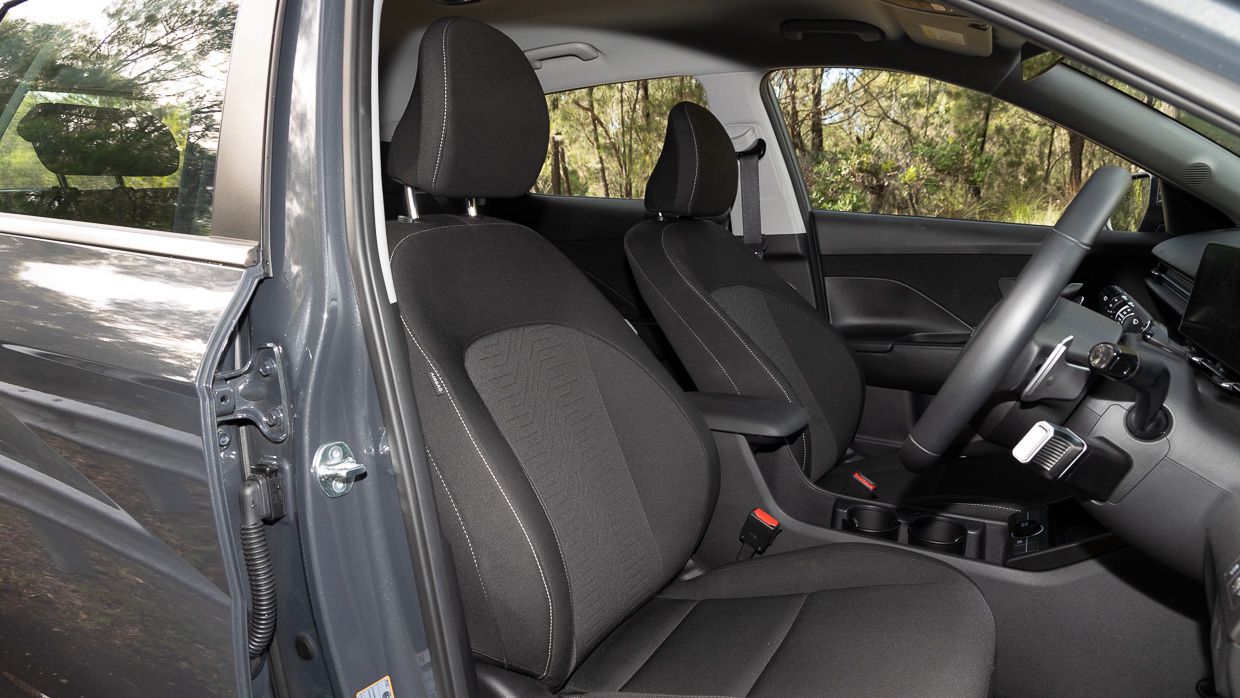
On the topic of annoying audible warnings, here’s a hot tip which could come in handy: for my first several weeks with the Kona I was extremely frustrated by a speed camera alert that would sound when approaching cameras, always interrupting podcasts or music at annoying moments.
I didn’t realise that this was tied to the in-car navigation, which I rarely used, if ever. So, if that’s something that annoys you, make sure you go into the navigation section of the infotainment to switch the alerts off, as opposed to the driver assistance section where I assumed this would be.
All in all, drawbacks aside, the Kona interior got a tick from me. The seats are comfy, the driving position is good, and the steering wheel is lovely.

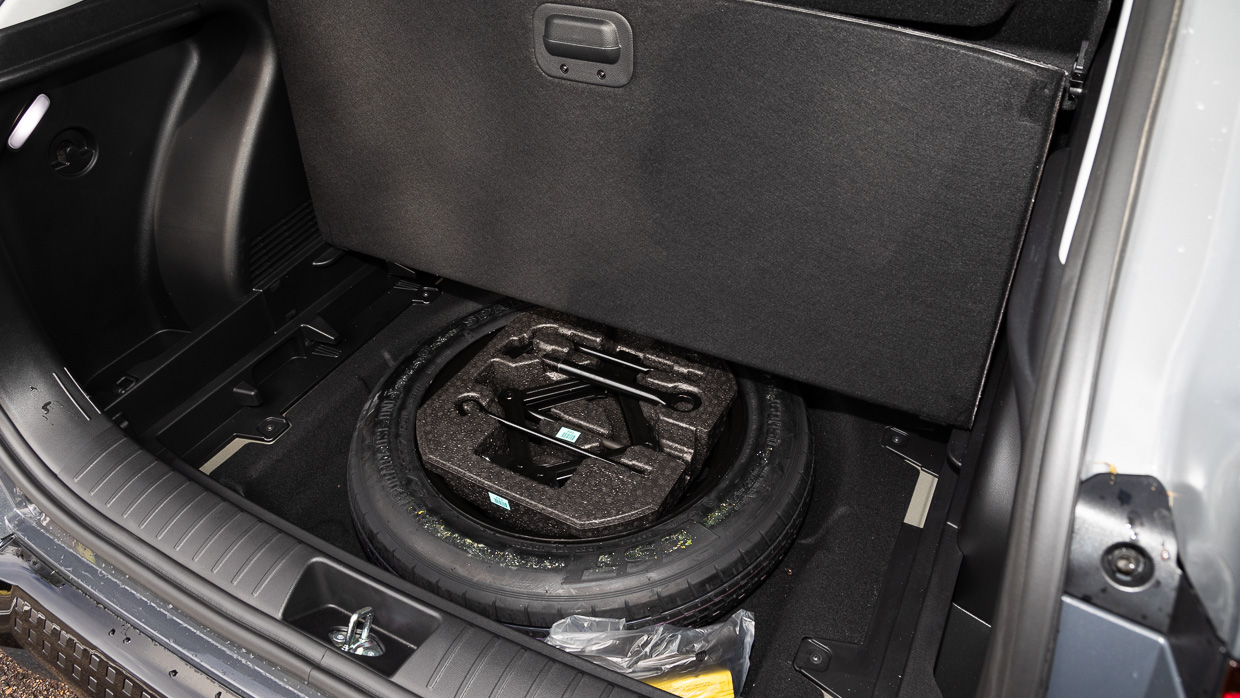
There’s good visibility, it’s spacious, and it’s well packaged with excellent room in the rear seats for passengers too – some friends commented that it didn’t feel like a ‘small SUV’ when I gave them a lift.
That solid packaging also continues in the boot. There are 407 litres of space, which is despite the vehicle accommodating a space-saver spare wheel!
I’ve said it before and I’ll say it again, the fact the Kona is an EV with some sort of spare wheel, as opposed to a tyre puncture repair kit or similar, should be applauded.
Month one was a period of getting acquainted with Agnes on two fronts – the actual vehicle, but also the lifestyle, which is where we’ll start.
Driving the Hyundai Kona Electric as a daily was a particularly big change for me given I’ve never had to live with an EV long-term beyond a week-long test car.
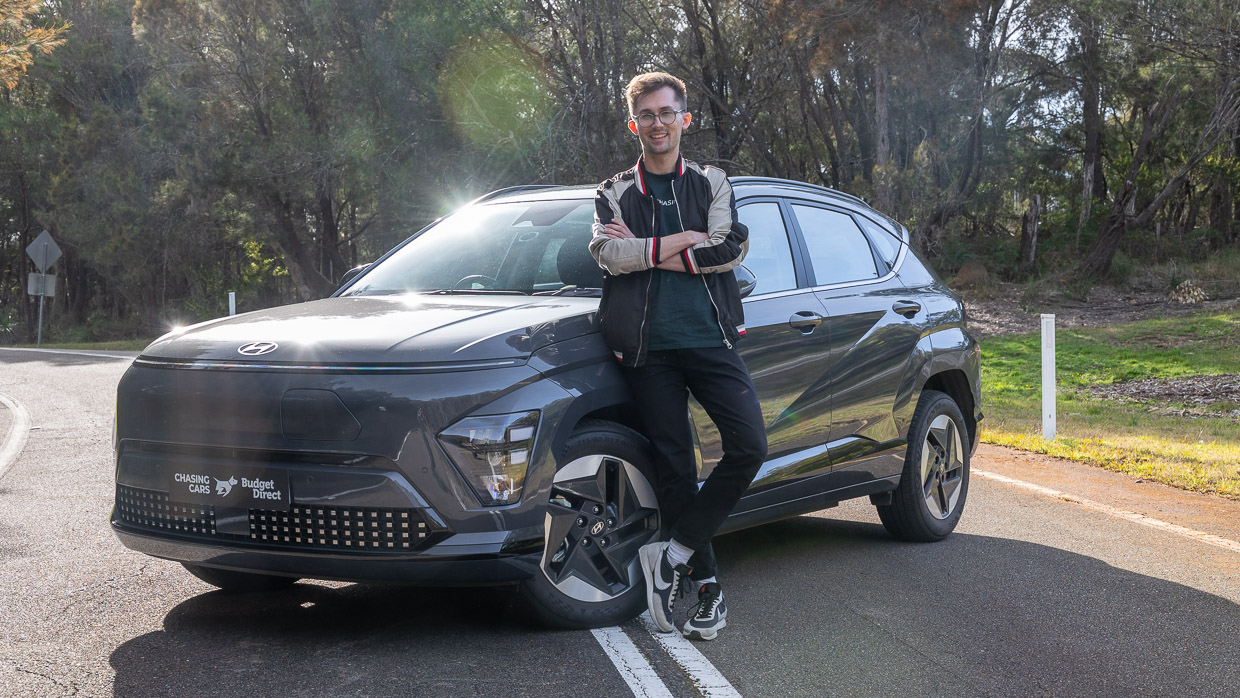
A six-month period requires some recalibration given that I don’t have the ability to charge the Kona at home by nature of the apartment I live in – there’s no powerpoint near my car spot, meaning I will be limited exclusively to Australia’s public charging infrastructure to charge the car.
That instantly meant a bit more logistical thought was required:how to maintain adequate charge? My daily commute is about 30km return – across the Harbour Bridge in peak-hour Sydney traffic both ways. Across five days that’s half the Kona’s range, excluding non-work-related travel, and that’s charge that I can’t simply top up overnight while I sleep.
My approach to this was simply looking at how I could align charging sessions with other tasks – for example, charging the car while I shop or have dinner with friends.
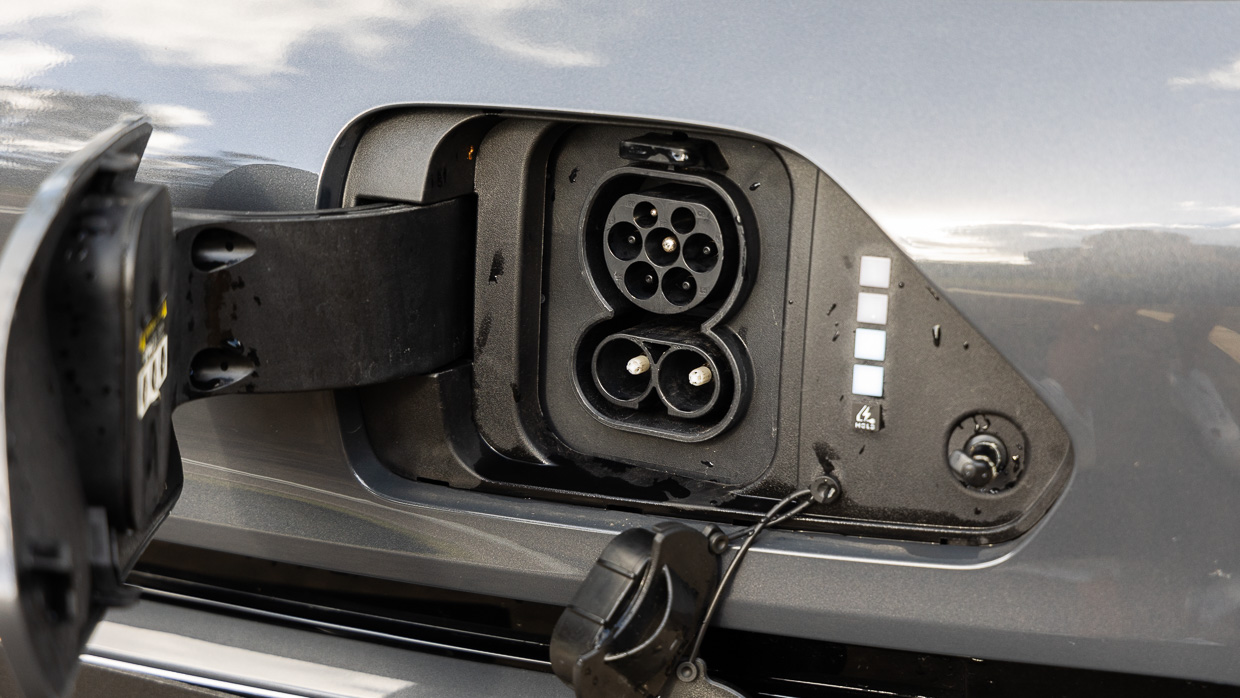
I soon found my favourite local charger – a 50kW EVIE charger in the local shopping complex, of which there were only two.
Sometimes I got lucky, but I also quickly became acquainted with the electric car waiting game: waiting for others to finish charging their cars, often while their vehicles to trickle over 80 per cent while they shop for hours on end. And while trying to keep my spot in the charing cue.
It made me wish there was a more formalised or structured ticket system with EV charging so that drivers could be placed in a queue rather than being subject to the wild west it can sometimes be.
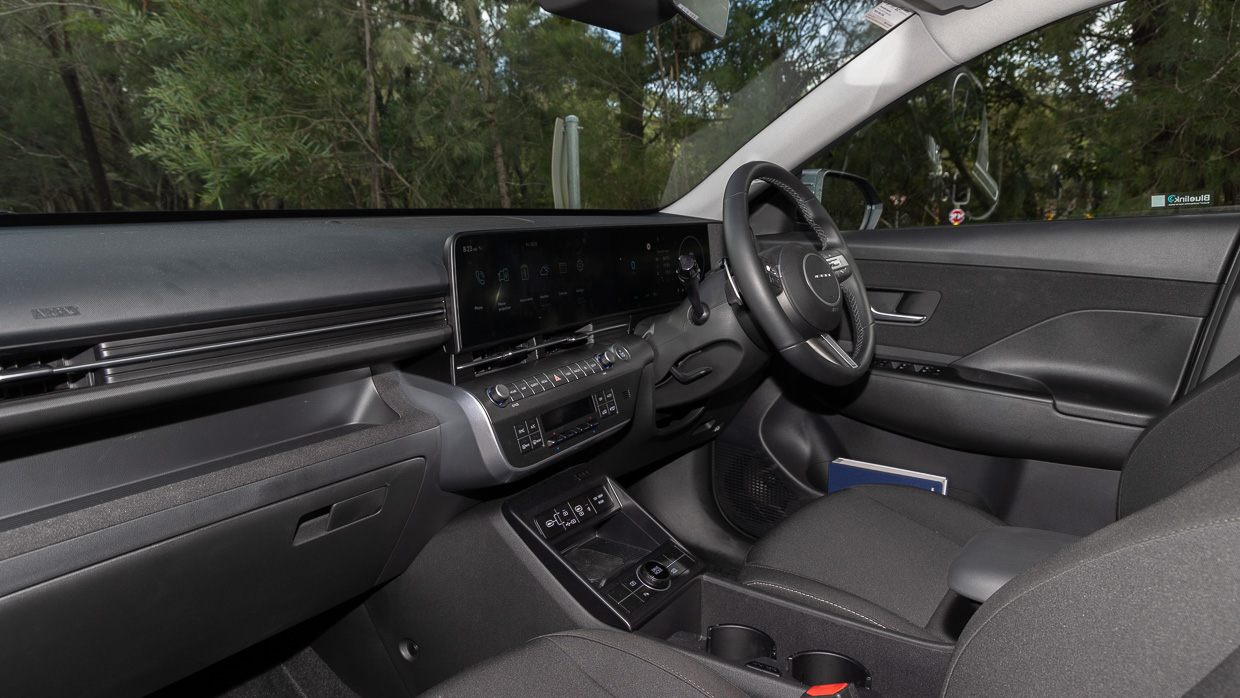
Nevertheless, I got into a routine relatively quickly and learnt to avoid peak hour during the day – evenings were where it was at for charging.
So – what about Agnes and my initial impressions?
Overall, these are positive. The cabin is what I would describe as honest – it’s a bit dark, with a lot of hard plastics that reveal its entry-level specification, but on the other hand it has a pragmatic blend between the functional and the modern.

I appreciate the clear and simple digital instrument cluster, and the media screen is quite intuitive, with Apple CarPlay working seamlessly.
We’ll see how the interior and tech stack up over the coming months.
The Kona Electric has also felt easy to use on the road.
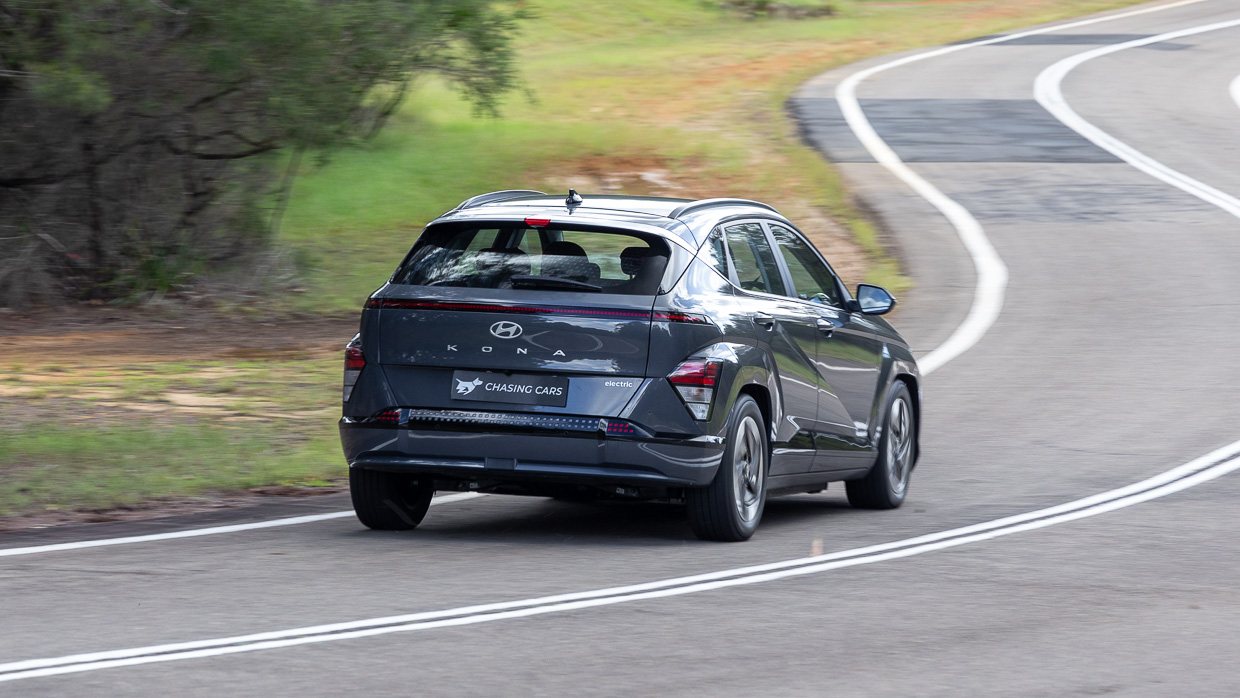
Ride quality is the stand-out feature so far. If some buyers might feel they are losing out by only having the smaller, 17-inch wheels on the base model, the upside is a ride that’s supple and wonderfully compliant – soaking up bumps and imperfections on the bumpy streets around my neighbourhood particularly well.
The benefits of electric vehicles in the daily grind of Sydney traffic compared to traditional petrol cars has also been notable… but more on how ‘Agnes’ stacks up in more rigorous testing over the coming months.
It’s our aim at Chasing Cars to run a variety of powertrain types – as well as different vehicle styles – in our long-term fleet, and with several petrol-powered SUVs in the garage already, our appetite was whetted to snag the keys for another electric car.
But which to choose? The only other EV in our garage was the slower-selling Ford Mustang Mach-E, so we were tempted by something smaller, more affordable, and more mainstream.
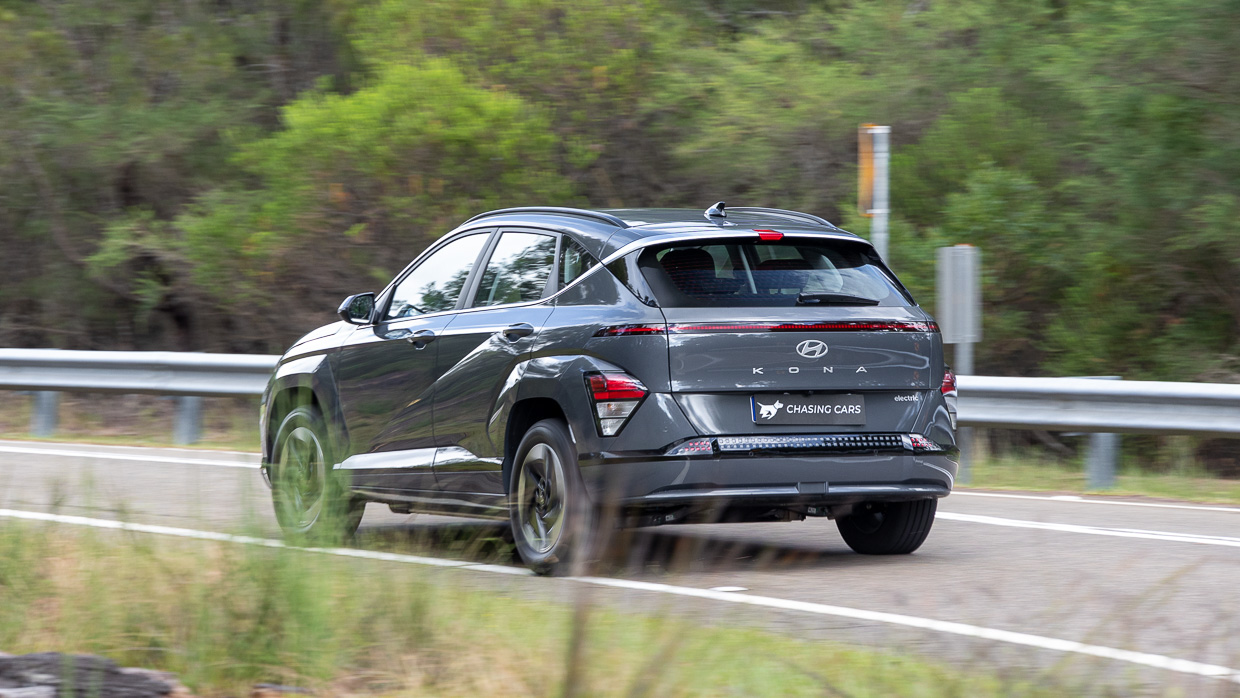
Enter the Kona, which we’ve affectionately dubbed ‘Agnes’!
When it comes to Australia’s small-SUV segment, the Kona is currently the second-biggest seller behind the MG ZS, and Hyundai’s second-highest selling nameplate year to date, narrowly behind the larger and recently facelifted Tucson midsize SUV.
The Hyundai Kona is also a rare breed of vehicle offering whatever powertrain flavour you desire: pure combustion, hybrid, or fully electric, with hybrids accounting for 23 per cent of sales and electrics 10 per cent in the first six months of 2024.
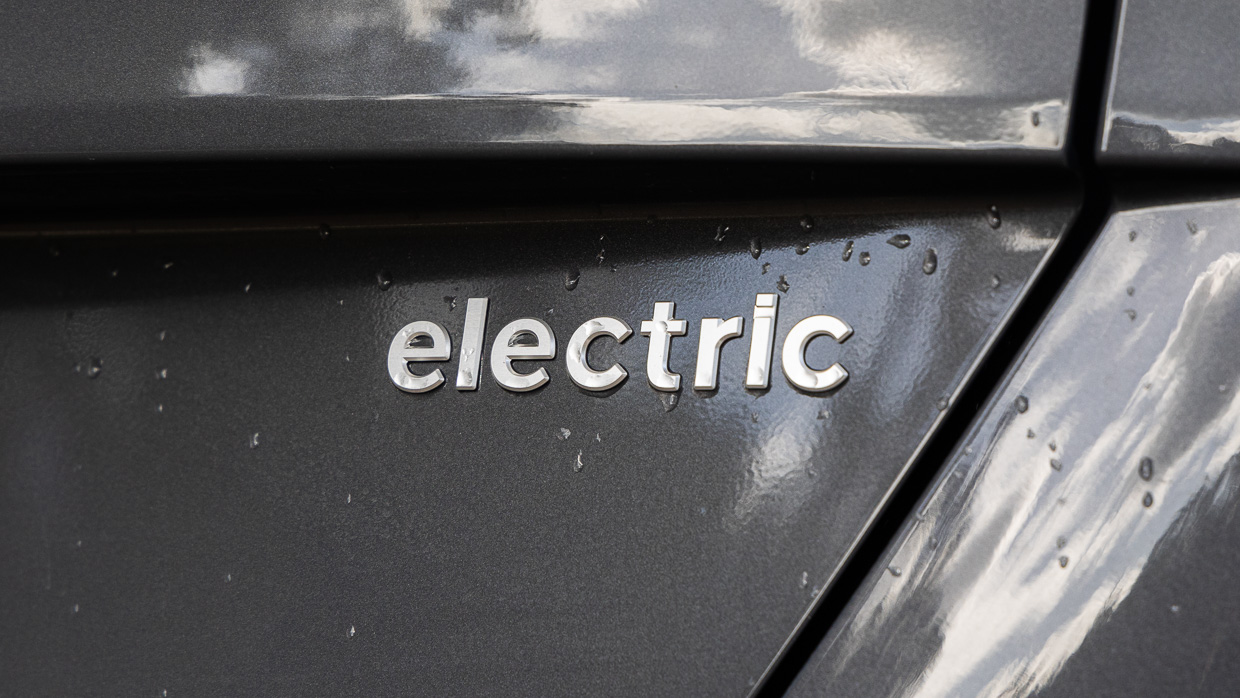
Importantly, the brand says the second-generation Kona was designed as an EV first before being reconfigured for its petrol and hybrid variants, so theoretically there’s no reason the electric variants shouldn’t be the best of the Kona range…
And, equally significantly, if you discount the MGs and BYDs of the world, the Kona is one of the surprisingly few electric small SUVs you can get below $60K from a mainstream legacy manufacturer, at least for now. And, until the smaller Inster arrives next year, this is the most affordable electric Hyundai you can buy.
So, a warm welcome to Agnes. Let’s find out what you’re like to live with.
The Kona Electric lineup is simple to navigate.
There’s the entry-level Kona Electric that you can get in Standard or Extended Range, while the extended range is also available in Premium specification with additional creature comforts.
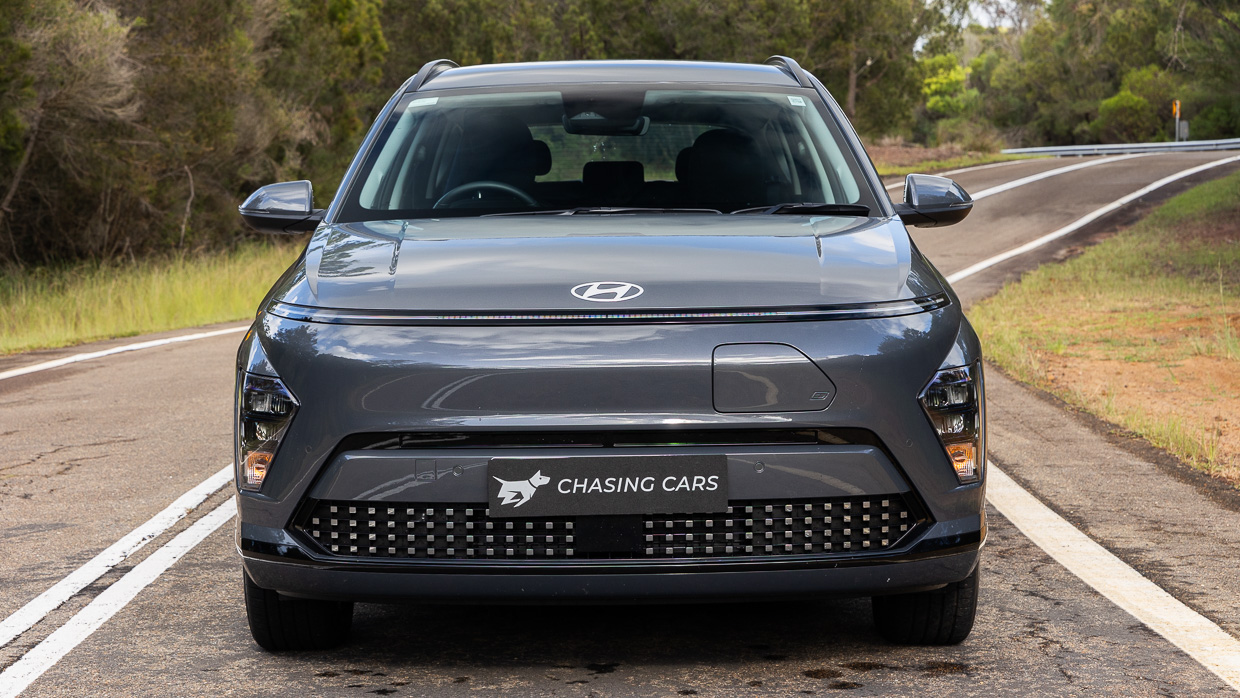
Aside from that, the only remaining choice is whether to option a sporty N-Line styling pack, available on both Extended Range variants.
So, which did we go for? Well, forget Extended Range, forget Premium, forget sporty N-Line packages… we have the bog-standard base-spec Kona Electric in Standard Range form, which will set you back $54,000 before on-road costs, or about $60,000 driveaway.
Our test car is specified in Ecotronic Grey premium paint, which adds $595 to the asking price.
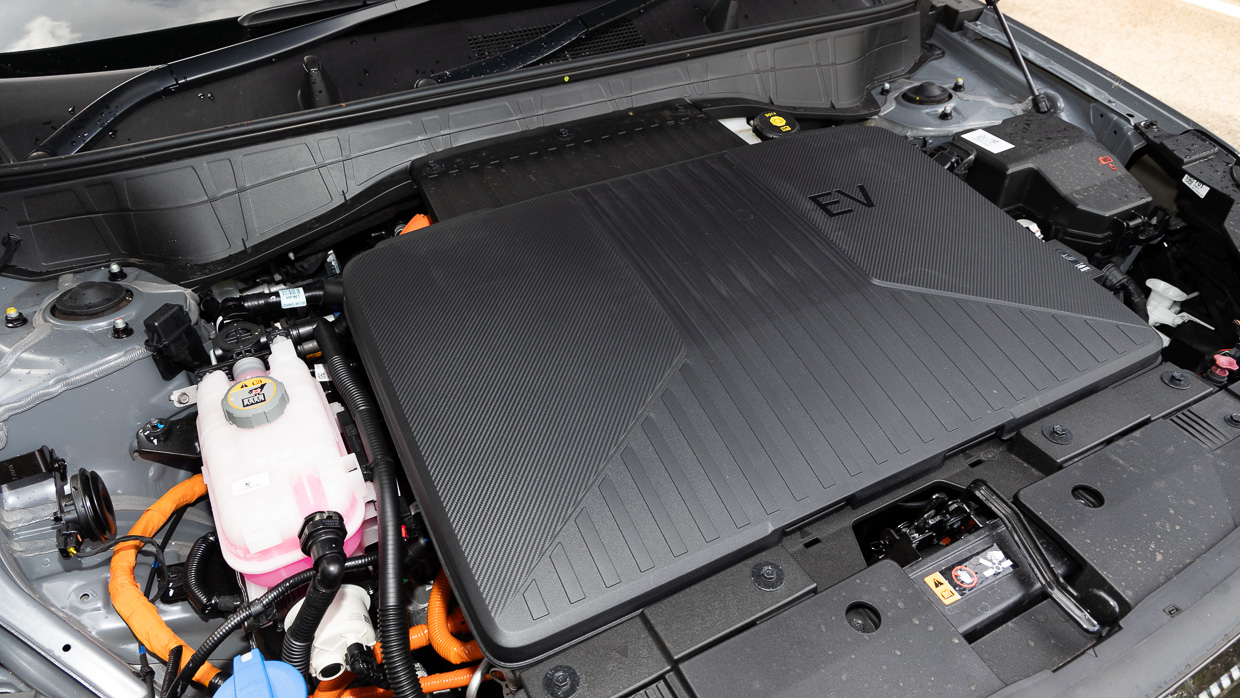
You’ll be able to identify it as an entry-level Kona by its 17-inch wheels, where the Premium and N-Line models run on 19s.
Under the bonnet, the base-spec Kona has a single front motor, with total outputs of 99kW and 255Nm, coupled with a 48.6kWh lithium-ion battery (gross) and a claimed WLTP range of 370km.
All variants are front-wheel drive, however the Extended Range receives a power bump to 150kW and an increase in range to 505km WLTP thanks to a larger, 64.8kWh battery (gross); the Extended Range Premium, which runs on larger 19-inch wheels, has a claimed WLTP range of 444km.
In terms of standard features, highlights include:

Below are key features buyers gain if opting for the higher-spec Premium:
Stay tuned for our monthly reports to see how ‘Agnes’ handles the daily grind as well as a few weekends away, our detailed thoughts on its interior and powertrain, our official Chasing Cars range and charging test results, and more.
Key specs (as tested)
About Chasing cars
Chasing Cars reviews are 100% independent.
Because we are powered by Budget Direct Insurance, we don’t receive advertising or sales revenue from car manufacturers.
We’re truly independent – giving you Australia’s best car reviews.
The estimate provided does not take into account your personal circumstances but is intended to give a general indication of the cost of insurance, in order to obtain a complete quote, please visit www.budgetdirect.com.au. Estimate includes 15%^ online discount.
^Conditions Apply
Budget Direct Insurance arranged by Auto & General Services Pty Ltd ACN 003 617 909(AGS) AFSL 241 411, for and on behalf of the insurer, Auto & General Insurance Company Limited(ABN 42 111 586 353, AFSL 285 571).Because we don’t know your financial needs, we can’t advise you if this insurance will suit you. You should consider your needs and the Product Disclosure Statement before making a decision to buy insurance. Terms and conditions apply.
Indicative quote based on assumptions including postcode , 40 year old male with no offences, licence suspensions or claims in the last 5 years, a NCD Rating 1 and no younger drivers listed. White car, driven up to 10,000kms a year, unfinanced, with no modifications, factory options and/or non-standard accessories, private use only and garaged at night.
^Online Discounts Terms & Conditions
1. Discounts apply to the premium paid for a new Budget Direct Gold Comprehensive Car Insurance, Third Party Property Only or Third Party Property, Fire & Theft Insurance policy initiated online on or after 29 March 2017. Discounts do not apply to optional Roadside Assistance.
2. Discounts do not apply to any renewal offer of insurance.
3. Discounts only apply to the insurance portion of the premium. Discounts are applied before government charges, taxes, levies and fees, including instalment processing fees (as applicable). The full extent of discounts may therefore be impacted.
4. We reserve the right to change the offer without notice.